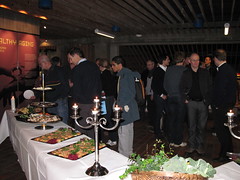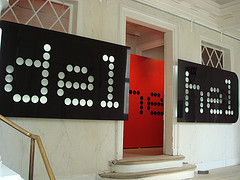Last Monday, we opened our latest exhibition, ‘Healthy Aging: A Life Span Approach’ in the main building of the Faculty of Health Sciences — produced by myself together with Bente Vinge Pedersen and Ion Meyer, and with the help of Jonas Bejer Paludan, Camilla Undén, Nanna Gerdes and Jacob Kjærgaard (all from Medical Museion); the showcase design and graphic design has skilfully been taken care of by Mikael Thorsted and Lars Møller Nielsen, Studio 8. See an earlier presentaton of the idea behind the show here, and images from the construction work here).

The show was set up in the new exhibitions area in the lobby of the Panum building on Blegdamsvej. To keep the content as secret as possible — and spur bypassers’ curiosity — the showcases were covered right until the opening.

Last minute adjustments of the spotlights.
It’s me down there introducing the idea behind the show to the audience.

The faculty generously paid for the reception, including sparkling fluids …

Here’s me presenting Liv Carlé Mortensen’s sublime photo collages to Allan Krasnik, Department of Public Health.

From left to right: Lars Møller Nielsen (graphic design), Mikael Thorsted (showcase design) and Medical Museion’s administrator, Carsten Holt.
Quite crowded reception — and lots of positive responses:

Thanks to Camilla Undén for sharing the pics above — for more images from the exhibition, see here.


 Last year
Last year 
 .
.  Special curator Camilla Undén removed old texts from the former exhibition (‘Primary Substances’):
Special curator Camilla Undén removed old texts from the former exhibition (‘Primary Substances’):